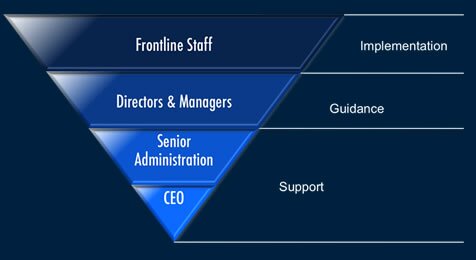|
Before improvements can take hold, a lean culture must be created. The focus of the culture-creating path of the lean implementation model is training, which is the first critical step to any culture change. Coupled with departmental implementation, which is an extension of the training, a solid knowledge base is established from which to initiate multi disciplinary events.
The most important element in creating a new culture is training. An organization's culture consists of beliefs, values, and attitudes based on employees' work experiences. Culture is the way people see and do their jobs. Before people can be expected to embrace a new culture, they need to know what the new culture entails. How will their jobs change? What are they expected to do differently? For what will they be held accountable? What do they need to learn? What is lean and what are the underlying principles? All of these questions must be answered up front through training before the implementation begins.
Lean employs top-down commitment and bottom-up implementation. Top-down commitment is essential to the successful creation of a lean organization. Equally important is the concept of bottom-up implementation. It is critical that lean implementation includes the participation of front-line staff and that it is not imposed from the top down. The organizational hierarchy for lean implementation is illustrated below. 
The CEO and senior administration are on the bottom of this hierarchy. This illustrates the concept of top-down commitment; these individuals form the narrow base that supports the rest of the organization. In the absence of this support, a lean organization will collapse as surely as an actual man-made structure would collapse. The next level of the organizational hierarchy for lean implementation is upper and middle management. Directors and managers are responsible for providing guidance to the front-line staff. These individuals must develop a thorough understanding of lean tools and principles.
Every application of lean tools and principles is different. Directors and managers must obtain the knowledge and develop the experience necessary to deal with a variety of scenarios to ensure successful outcomes. This level of knowledge and experience is developmental and involves a process that begins with training, advances through the departmental application, and culminates with leading kaizen events.
At the top of the organizational hierarchy is the front-line staff. These individuals are closest to the daily operation of the business and the ones who must internalize and live with the changes. It is only logical that they should be the ones to implement the changes. Training should be commensurate with the three levels defined by the lean organizational hierarchy depicted above: support, guidance and implementation. Recommended training is as follows:
- Executive overview: Training and discussion targeted at providing senior leaders with a thorough understanding of lean principles and their leadership role in supporting the lean transformation.
- Lean healthcare workshop: A workshop for directors and managers to provide them with a solid understanding of lean tools and principles so that they can guide front-line staff in successful implementation of lean improvements.
- Lean overview: Training sessions targeted at providing front-line staff with an understanding of lean and the organization's objectives and direction.
Lean hospitals, offers a variety of training option:
Lean Hospitals also offers certification programs for:
Six Sigma Green Belt: This education program prepares participants for the Six Sigma Green Belt Certification exam. Participants will develop a sound technical foundation in Six Sigma tools, and will learn and apply the DMAIC (Define, Measure, Analyze, Improve and Control) improvement method.
Lean-Six Sigma Black Belt: This program prepares participants for the Lean Six Sigma Black Belt Certification exam. This training provides the management and analytical skills necessary to implement the tools, principles and practices of Lean Six Sigma.
|